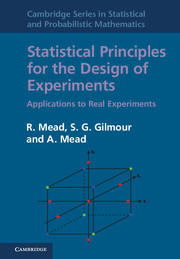0 - Designing useful experiments
from Part IV - Coda
Published online by Cambridge University Press: 05 November 2012
Summary
Some more real problems
Many of the problems considered in previous chapters have occurred during statistical consultancy sessions and are appropriate to motivate this chapter. Typical examples are the peppers experiment in Chapter 7 and the rabbits experiment in Chapter 15. Three more problems occurred in the work of one of us (RM) in quick succession within three weeks in early 1984 and illustrate a wide range of practical design problems.
(a) Problem 1: the moving cups. In assaying the chemical concentration of liquid samples, a set of about 24 samples can be automatically assayed in a single batch. The samples are placed in cups which are held in position on a circular disc, and the disc rotates so that each cup in turn appears beneath the assay machinery. It is required to investigate changes in the concentration of chemicals over time, and therefore the 24 samples are assayed over a time period of between one and two hours. Two shapes of cup are available, and two sizes of sample are possible within each cup. Three chemicals, sodium (Na), chlorine (Cl) and potassium (K) are of interest, and it is proposed to have two levels (zero and some) for each chemical. The cups may be covered during the run of 24 samples until each is sampled, but the covers, if used, must be used for all 24 samples in the run. […]
- Type
- Chapter
- Information
- Statistical Principles for the Design of ExperimentsApplications to Real Experiments, pp. 538 - 564Publisher: Cambridge University PressPrint publication year: 2012
- 1
- Cited by

